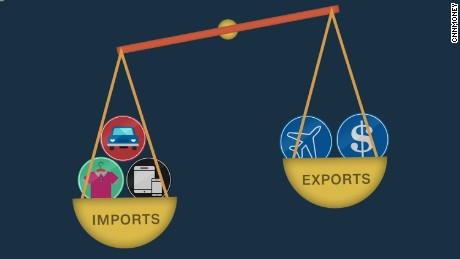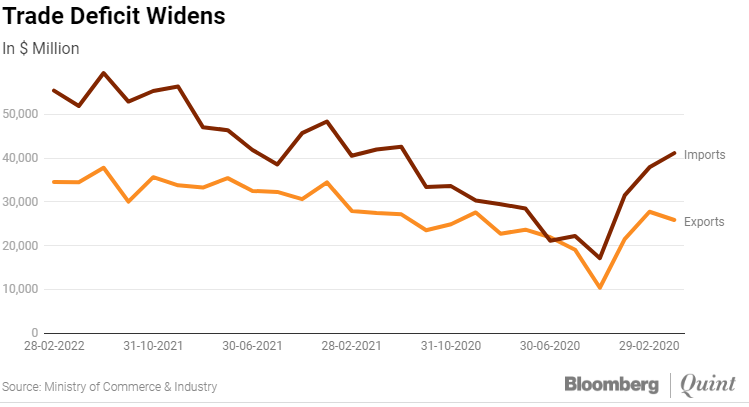Description

Disclaimer: Copyright infringement not intended.
Context
- India’s merchandise exports in May rose by 20.6% to $38.94 billion, while the trade deficit ballooned to a record $24.29 billion. Imports surged 62.8% to $63.22 billion. The trade deficit stood at $6.53 billion in the same month last year.
Reasons behind such high Trade Deficit
- Petroleum and crude oil imports more than doubled to $19.2 billion.
- Coal, coke and briquettes imports jumped to $5.4 billion, from $2 billion.
- Gold imports increased to $6 billion, from $677 million in May 2021.
- Engineering goods exports increased by 12.7% to $9.7 billion, while petroleum products exports grew by 60.9% to $8.54 billion.
- Gems and jewellery exports stood at $3.22 billion compared with $2.96 billion in May 2021.
- Exports of chemicals rose 17.4% to $2.5 billion in May.
- Similarly, shipments of pharma and ready-made garments of all textiles grew by 10.3% and 27.9% to $2 billion and $1.41 billion, respectively.
Note: Export sectors that recorded negative growth in May included iron ore, cashew, handicrafts, plastics, carpet and spices.
Trade deficit
- A trade deficit is an amount by which the cost of a country's importsexceeds its exports.
- It's one way of measuring international trade, and it's also called a negative balance of trade.
- A trade deficit can be calculated by subtracting the total value of a country's exports from the total value of its imports.
What Causes a Trade Deficit?
It can be hard to pinpoint the exact cause of a trade deficit. Typically, multiple factors are at play. Here are some of the leading causes of an increase in a country's trade deficit.
- Economic growth: A large trade deficit can actually indicate economic growth. When the economy of a country grows and strengthens, consumers have more wealth to purchase goods from overseas, which will increase the trade deficit. A strong economy also attracts foreign investors, further enlarging the trade deficit.
- Increased government spending: An increase in government spending can mean a country's savings diminish, increasing the trade deficit.
- Changes in exchange rate: A change in the strength of a country's currency can impact the trade deficit. When a country's currency weakens relative to other nations, trade between other countries becomes more costly. If a country’s currency is strong, it may want to import more goods or services.
- Limits of production: Certain goods simply cannot be produced domestically, or are much cheaper to produce abroad due to climate, natural resources, or other reasons. For example, a small island nation may rely on imports of agricultural products from the mainland.
- Removal of barriers to trade, such as tariffs: Trade policy can have an effect on the trade deficit, but unless the country was previously closed to trade, trade policy mostly serves to shift the trade deficit toward another trading partner, rather than creating or increasing the overall trade deficit.
Potential Effects of a Trade Deficit
Here are some of the ways a trade deficit can affect a country’s economy.
Lower prices
- A country may have a trade deficit because it is cheaper to purchase goods internationally than to produce them at home. This means that prices of consumer goods and services may decrease.
Weakening currency:
- A trade deficit has the potential to weaken a country’s currency.
Deflation:
- A country that has a trade deficit is sending a portion of its currency overseas. This can cause deflation, a state in which reduced demand leads to lower prices.
Changes in employment:
- If a country imports more than it exports, unemployment may increase. For example, if a country shifts from manufacturing cars to importing cars from international car manufacturers, the job market for car manufacturing will be negatively impacted. Some economists argue that the reduced prices caused by a trade deficit can make up for these losses, by allowing resources to be allocated to new jobs, while others suggest that workers displaced by shifts in trade are unlikely to benefit from jobs created in other fields.
Decrease in GDP:
- Trade deficit is one factor used to calculate a country’s Gross Domestic Product (GDP), a measure of the size of the economy. If the trade deficit increases, the GDP decreases.
India’s Trade Deficit status
India's trade deficit widened as imports rose.
- Exports rose 25.1% year-on-year and 0.2% over the previous month to $34.57 billion.
- Imports rose 36.1% year-on-year and 6.8% over the preceding month to $55.45 billion.
- Non-petroleum and non-gems & jewellery exports in February were at $26.75 billion, a growth of 19.01% year-on-year.
- Non-petroleum, non-gems & jewellery- gold, silver and precious metals, imports were at $31.70 billion, a growth of 32.04% year-on-year.
- With a much sharper annual growth in non-gold imports relative to aggregate merchandise exports, the merchandise trade deficit rose in February 2022.
- With the sharp rise in the trade deficit, the current account deficit is expected to have crossed 3% in Q3 FY22, for the first time since the June 2013 quarter.

Key Export Items
- Engineering goods exports stood at $9.3 billion, up 32% year-on-year.
- Petroleum product exports were at $4.6 billion, 88.1% higher than a year earlier.
- Gems and jewellery exports were at $3.2 billion, 18% higher on an annual basis.
- Drugs and pharmaceutical exports were at $2 billion, 1.8% lower over the year ago.
Key Import Items
- Petroleum, crude and product imports were up 69.2% over a year earlier at $15.3 billion.
- Electronic goods imports were at $6.3 billion, up 29.5% over a year earlier.
- Gold imports stood at $4.8 billion, 9.7% lower than a year ago.
- Imports of coal, coke and briquettes were 117% higher than a year ago at $2.9 billion.
Must Read
https://www.iasgyan.in/daily-current-affairs/current-account-deficit-16
https://www.iasgyan.in/blogs/key-economic-concepts-back-to-basics
https://www.iasgyan.in/blogs/inflation-all-you-need-to-know
https://www.iasgyan.in/daily-current-affairs/monetary-policy
https://www.iasgyan.in/blogs/budget-basics-key-financial-terms-you-need-to-know
https://indianexpress.com/article/business/economy/current-account-deficit-likely-to-hit-10-year-high-7814251/
https://epaper.thehindu.com/Home/ShareArticle?OrgId=GUA9PB5NB.1&imageview=0
1.png)















